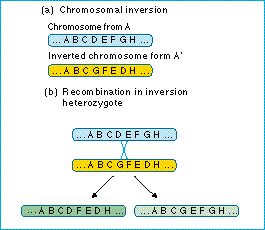Chromosomal inversion

An inversion is a type of mutation where a sequence of nucleotides in the DNA is reversed, or inverted. Sometimes inversions are visible in the structure of the chromosomes and are called chromosomal inversions.
Chromosomal inversions protect sets of epistatically interacting genes from recombination, so that the genes in an inversion will behave as a 'supergene' and segregate as if they were a single Mendelian locus.
Chromosomal inversions can be used to infer phylogenetic relations. An animation shows how this is possible.
Figure: (a) a chromosomal inversion has a set of genes inverted. The letters represent genes along the chromosomes. (b) Recombination in a heterozygote can produce chromosomes that lack some genes and have others in double dose. These forms are probably selected against.
| Next |



